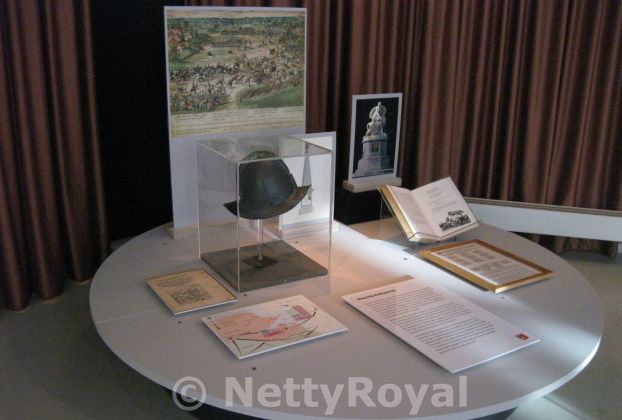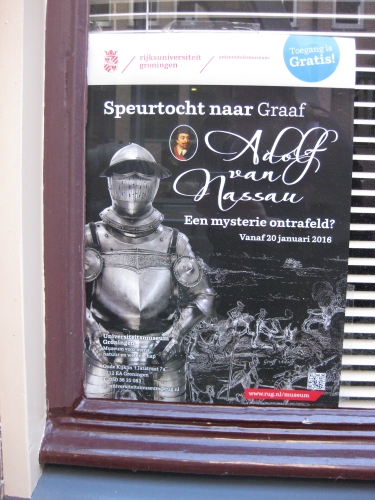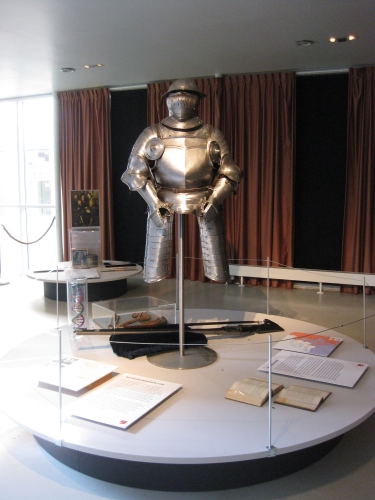Graaf Adolf is gebleven (Count Adolf stayed behind)
in Friesland in de slag, (in battle in Frisia)
zijn ziel in ‘t eeuwig leven (His soul in the eternal life)
verwacht de jongste dag. (awaits the final judgement)
These are the last lines of the fourth verse of the Dutch national anthem (there are fifteen verses, just for your information). Who is this Count Adolf?
He was born in Dillenburg on 11 July 1540 as fourth of the five sons of Count Wilhelm I “The Rich”of Nassau-Dillenburg and his second wife Countess Juliana zu Stolberg. And he was killed in action in 1568. 1568 is seen as the starting year of the Eighty Years’ War, also called the Dutch War of Independence – a revolt of the seventeen Dutch provinces against the Spanish. Leader of the revolt was Willem I “The Silent”, Prince of Orange, Count of Nassau, the eldest brother of Adolf. Willem and his brothers Ludwig and Adolf gathered an army and in 1568 invaded the Netherlands from three sides. Ludwig led the troops that were to enter the country through Friesland, in the northeast of the country. Adolf came along with him. In the meantime the Spanish troops under the command of Jean de Ligne, Duke of Arenberg gathered in the area. On 23 May 1568 the Spanish and Dutch met at Heiligerlee, a village not very far from the German border. Ludwig survived, Adolf however, only 27 years old, was killed. Ludwig himself was killed in action, as well as did the youngest brother Heinrich, in the battle of the Mookerheide on 14 April 1574. Their bodies were never recovered. Willem himself was murdered in Delft on 10 July 1584. Johann VI (1536-1606) was the only one of the five brothers who managed not to be killed during the Eighty Years’ War
There is a museum in Heiligerlee about the battle, and a monument was erected there for Adolf in 1868 on the occasion of the 300th anniversary. For centuries historians and researchers have wondered, what did actually happen to Adolf? There were some interesting articles about it in Dutch and German newspapers last week which made me curious. The Groninger historian Lammert Doedens for many years searched for the final resting place of Adolf, and thinks he has finally solved the mystery after almost 450 years.
Although some stories say that he was killed on the battlefield by the Duke of Arenberg personally, shortly before he died himself, Doedens thinks that is incorrect. However Adolf must have found himself surrounded by Spanish troops and was killed. When Ludwig inspected the battlefield the day afterwards – the Dutch had won – he found the body of his brother. Both Adolf and the Duke of Arenberg were taken to the monastery church of Heiligerlee, where they were likely enbalmed. The body of Adolf was taken to the Castle in nearby Wedde and buried there. Already a few days later the body was removed in the middle of the night on request of Ludwig. The situation in the area was still too insecure and he didn’t want his brother’s remains to fall into the hands of the Spanish. But where was Adolf taken to? At the time only a few people must have known. And when the war was finally over, nobody who had known was alive. All that seems to be pretty certain, is that he was buried in a nearby town in Germany.
Doedens came to the conclusion that they might well have tried to take Adolfs remains back home to Dillenburg, but they never arrived there, that’s for sure. But along which route would they have travelled into the direction of Dillenburg? Rumours go that Adolf was buried at the vault of the Counts of Ostfriesland (East Friesland) in Emden, where supposedly also his armour (or that of Ludwig) is still being kept at the Ostfriesisches Landesmuseum. However the archives of the church in Emden don’t mention Adolf and in 1943 the church and the vault were destroyed in an air raid. The remaining parts of the skeletons were buried in the Mausoleum of the Counts of Ostfriesland in Aurich. Doedens did research in the Johannes Lasco Library in Emden but came up with nothing. Emden also was not a very logical burial place as that was up north and probably too close to the enemy. A route to the south was impossible, as this area remained Catholic and was thus dangerous for the Protestant Dutch. Most plausible would have been if they had taken Adolf to the east via Oldenburg, to try to get him to Dillenburg through protestant soil.

When Doedens held a lecture about Adolf an archaeologist afterwards came up with an interesting theory. He told him about the renovation of the vault in the Lamberti Church in Oldenburg in 1937. The Rev. Ralph Hennings of this church informed him that during renovation several coffins had been found. Among them the coffins of Count Anton von Oldenburg and his wife. But also some remains of about five other people. A complete skeleton was found at the very bottom of the vault, but in 1937 nobody had any idea who he was and the remains were placed back in the vault. Ralph Hennings says he thinks it could also be Count Christoph von Oldenburg. In the Royal House Archives in The Hague Doedens found out that Count Anton von Oldenburg had actually known the family. In 1567 Anton had been one of the godfathers of Willem of Orange’s son Maurits, and together with two sons had attended the christening in person. Ludwigs troops had been allowed to pass through Oldenburg and Oldenburg troops even fought side by side with the Dutch.
The coming months will be very exciting. The University of Göttingen has paid for DNA-research, and permission has been given to open the vault in Oldenburg. There is also permission to exhume the remains of Adolfs sister Catharina (1543-1624), who was married to Count Günther XLI zu Schwarzburg-Arnstadt. She was buried in the Liebfrauenkirche in Arnstadt. The DNA will then be compared. Doedens himself is quite positive about the results and thinks there is a 75 % chance that the remains in Oldenburg are Adolf’s. That would make an end to the almost 450 years of uncertainty about the burial place of Count Adolf.



A tiny, tiny exhibition called “Speurtocht naar graaf Adolf van Nassau” (Quest for Count Adolf von Nassau) opened on 20 January 2016 at the University Museum in Groningen, The Netherlands. To my opinion – I went to see it today as I live nearby (and accidentally also saw Mr Doedens, although I didn’t talk to him) – much too small for a special trip to Groningen. But when you’re in town anyway, just go and have a look as it is very small but interesting. The entrance is free. The museum is open from Tuesday to Sunday, 1pm to 5pm.
